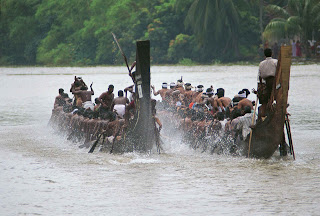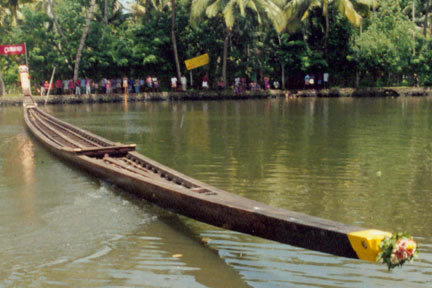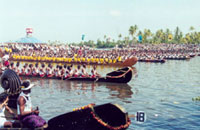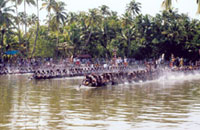 The Nehru Trophy Boat Race on the Punnamda Lake, near Alappuzha, held on the second Saturday of August every year, is the most competitive and popular of the boat races. There are several boat races in Kerala like Champakulam, Pulinkunnu, Aranmula Cheruthana, etc but the Nehru Trophy Boat Race held at the Punnamada Lake is the most famous and popular among them.On the day of this fiercely fought boat race, the tranquil lake front is transformed into a sea of humanity with an estimated two lakh people, including tourists from abroad, coming to watch the event. For the people of each village in Kuttanad, a victory at this race for their village boat is something to be celebrated for months to come.
The Nehru Trophy Boat Race on the Punnamda Lake, near Alappuzha, held on the second Saturday of August every year, is the most competitive and popular of the boat races. There are several boat races in Kerala like Champakulam, Pulinkunnu, Aranmula Cheruthana, etc but the Nehru Trophy Boat Race held at the Punnamada Lake is the most famous and popular among them.On the day of this fiercely fought boat race, the tranquil lake front is transformed into a sea of humanity with an estimated two lakh people, including tourists from abroad, coming to watch the event. For the people of each village in Kuttanad, a victory at this race for their village boat is something to be celebrated for months to come.
The major attraction of the boat race is the competition of snake boats chundanvallams or snake boats.Chundans(snake boats) are an impressive sight, measuring over 100 feet in length, with a raised prow. They were called snake boats by the former colonial rulers, who based the name on a native boat found in Norway,although Kerala's Chundans bear little resemblance to their European namesakes.
The history of the Nehru Trophy Boat Race is associated with the visit of late Pandit Jawaharlal Nehru, the then Prime Minister of India to Alappuzha. He chanced a trip from Kottayam to Alappuzha by boat, through water logged Kuttanad.A pageantry of boats accompanied him on the trip.The first race was an impromptu once conducted in 1952 in honour of Panditji who visited Alappuzha. In that race of snake boats, Nadubhagam Chundan stood first. Panditji, who was thrilled and excited in the performance of the oarsmen, jumped into the Nadubhagam Chundan, forgetting all security arrangements.The boat proceeded to the boat jetty carrying the Prime Minister.On his return to Delhi in December 1952, Nehru donated a Silver Trophy, which is a replica of a snake boat placed on a wooden abacus.The trophy bears the following inscription above his signature.
In that race of snake boats, Nadubhagam Chundan stood first. Panditji, who was thrilled and excited in the performance of the oarsmen, jumped into the Nadubhagam Chundan, forgetting all security arrangements.The boat proceeded to the boat jetty carrying the Prime Minister.On his return to Delhi in December 1952, Nehru donated a Silver Trophy, which is a replica of a snake boat placed on a wooden abacus.The trophy bears the following inscription above his signature.
“To the winners of the boat race which is a unique feature of community life in Travancore Cochin."
This trophy later came to be known as Nehru Trophy, and in fond memory of great Panditiji, the people of Alappuzha celebrate the Nehru Trophy Boat Race every year.
The race courser having a length of about 1370 meters is divided into various tracks for the conduct of the competition.When they are advancing through various tracks, it appears like the fast moving snakes.The oarsmen splash the oars in unison with the rhythmic chants and beats of drums.The movements of competing boats are so thrilling that the spectators get a tune with the excited mood of the surrounding uproars.The festival begins with a procession of the snake boats. The snake boats and the smaller varieties of Kerala race boats like the ‘Churulan’, ‘Veppu’ and oadi’ move in a formation down the 1.4 KM stretch of the lake as the sturdy villagers, their biceps rippling in the sun, row with an elaborate flourish of the oars to the singing of couplets from “Kuchelavritham Vanchipattu” the classic Malayalam poem written by Ramapurathu Warrier to regale King Marthanda Varma of Travancore in early 19 century during a boat journey from Vaikom to Thiruvananthapuram.  The numerous beaded umbrellas held aloft in each boat, the gilded sterns of the ebony black snake boats and the changing patterns that the rowers weave with their oars transform the lake into a kaleidoscope. Floats giving glimpses of Kerala’s rich cultural heritage follow the race boats, with artists performing “kathakali” “theyyam” “panchavadyam” and “padayani".
The numerous beaded umbrellas held aloft in each boat, the gilded sterns of the ebony black snake boats and the changing patterns that the rowers weave with their oars transform the lake into a kaleidoscope. Floats giving glimpses of Kerala’s rich cultural heritage follow the race boats, with artists performing “kathakali” “theyyam” “panchavadyam” and “padayani".
And then a quiet falls on the lake front, broken only by the sound of ripples lapping the embankment and the rustle of palm leaves in the wind. 
 The snake boats line up at the starting point for the great race. As the starter’s flag goes up, the scence freezes into a tableau the rowers tense with their paddles poised, the pace keepers alert and the steersmen straining against their long oars. The flag falls in a blur and suddenly the thumping begins. The crowd erupts into a roar, birds flutter up from their perch on the trees and the snake boats hiss their way down the lake in a haze of spray, fighting a pitched battle in the dappled waters. “Ayyo-poyye ayyo-poyye” – the cadence grows to a crescendo as the oars dip and flash 100 to 120 times a minute and the steersmen hurl their gigantic oars in a high arc.
The snake boats line up at the starting point for the great race. As the starter’s flag goes up, the scence freezes into a tableau the rowers tense with their paddles poised, the pace keepers alert and the steersmen straining against their long oars. The flag falls in a blur and suddenly the thumping begins. The crowd erupts into a roar, birds flutter up from their perch on the trees and the snake boats hiss their way down the lake in a haze of spray, fighting a pitched battle in the dappled waters. “Ayyo-poyye ayyo-poyye” – the cadence grows to a crescendo as the oars dip and flash 100 to 120 times a minute and the steersmen hurl their gigantic oars in a high arc.
Preparations for the big event begin several weeks in advance. The snake boat is smeared with sardine oil for smooth passage through water, the best oarsmen are selected and, under the supervision of the senior most oarsmen, the practice sessions begin. Around 150 oarsmen, who would represent the village, take the vow to observe strict abstinence and celibacy till the oars to each of them. Each ward in the village and at time rich individuals takes their turn in feeding the athletes on the days of the practice at mass feasts on the river banks.Even in the days of untouchables, this was a feature of the regattas with caste Hindus, Scheduled Castes, Christians and Muslims sitting in the same row for the feast symbolising the communal amity in Kuttanad. In fact, the Church has a traditional role in the celebrations at Champakkulam though the water festival there is associated with a temple legend.
